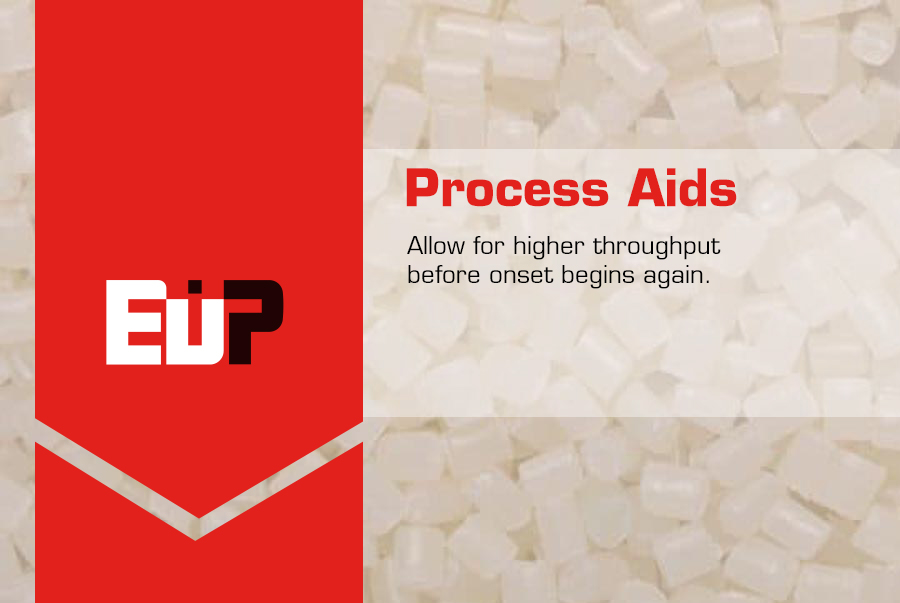 Processing Aids
Processing Aids
The main and nearly most important competitive advantage in doing business is low price. How do you achieve that advantage? By optimising your material cost and operating cost, right?
The plastic industry now is highly competitive with ever-increasing cost reduction among manufacturers. That’s why process aids are being called cost reducers or cost savers. Process aids not only ultimately decrease the rate of defect production and cycle times, but also ensure processing temperatures and high output rates.
1. How does processing aids work?
Process aids are used in very small quantities to enhance properties and minimize defects in final products. Some impact modifiers and lubricants also bring positive effects on manufacturing.
1.1. Eight functions of processing aids
The 3 first important are:
- Avoid defects: sharkskin and melt fracture
- Decrease the time required and increase productivity for the process of forming a crosslinked gel and other kinds of build-up in the extruder die.
- Enhance surface finish
Other 5 functions are:
- Improved throughput rates
- Reduced pressure in the die; reduced motor torque
- Increased strength of end products
- Easier mold release in injection molding
- Improved cavity filling in injection molding
Read more: What are plastic additives? 8 most common plastic additives in plastic industry
1.2. How processing aids really help your business?
Generally, process aids are used mainly in PE and PVC applications.
Some PP grades with narrow molecular weight distribution and certain styrene polymers, polyamides, acrylics, and thermoplastic elastomers also benefit from process aids.
Using process aids help the breakage of molten polymer in processing.
Melt fracture is a matter in LLDPE because it has a narrow molecular weight distribution.
Let me first explain why melt fracture happens.
In cyclic melt fracture, the stress and pressure at the die wall are enough to separate the polymer from the metal surface. Repeat the cycle many times can increase output; however, it also reduces the stress and pressure. Therefore, it allows the polymer to stick to the die wall and melt fracture happens.
The great solution is to coat the die wall with a suitable process aid.
EMPA 05D from EuP can help you with it. It works perfectly.
EMPA 05D is low surface energy, polymeric process aid. It sticks to the metal, and it does not adhere to the polymer being extruded.
Gradually, a coating of process aid builds upon the metal surface as the polymer passes through the die.
You can add particulate pigments, anti blocks, and fillers to accelerate the erosion rate.
It is necessary for you to minimize the time required for the process aid coating to build upon the die wall. It usually takes from 5 minutes to 1 hour to build up a layer. During that time, the output generated may be defective.
Adding a copolymer of hexafluoropropylene and vinylidene fluoride, with trifluoromethyl side groups or a fluoropolymer can prohibit melt fracture.
The copolymer can also be accomplished by other polymers or additives.
Besides, you can copy with a rough matt or ‘orange peel’ finish. It is a sign of sharkskin, it usually happens at high extrusion rates in the extrusion die
Fortunately, calcium carbonate can tackle the problem as a processing aid. It boosts the stiffness and strength of the products and enhances output.
2. You need an expert in plastic additives field
Process aids can sometimes interact with other additives and lose some of their effectiveness.
You need advice from professionals to choose the right process aids and give you advice on which additives you can use with process aids to avoid adverse effects.
EMPA 05D in granular form can help you overcome these problems.
It targets PE and PP applications. EMPA 05D eliminates orange peel surfaces and improves the transparency and mechanical properties of the extruded product. It also increases extrusion speed, eliminating knots and drool in the extrusion dies.
It is usable in injection molding as well as extruded or extrusion blow molding products.
Additionally, the R&D department from EuP will support and give you the advice you need to achieve the best result.